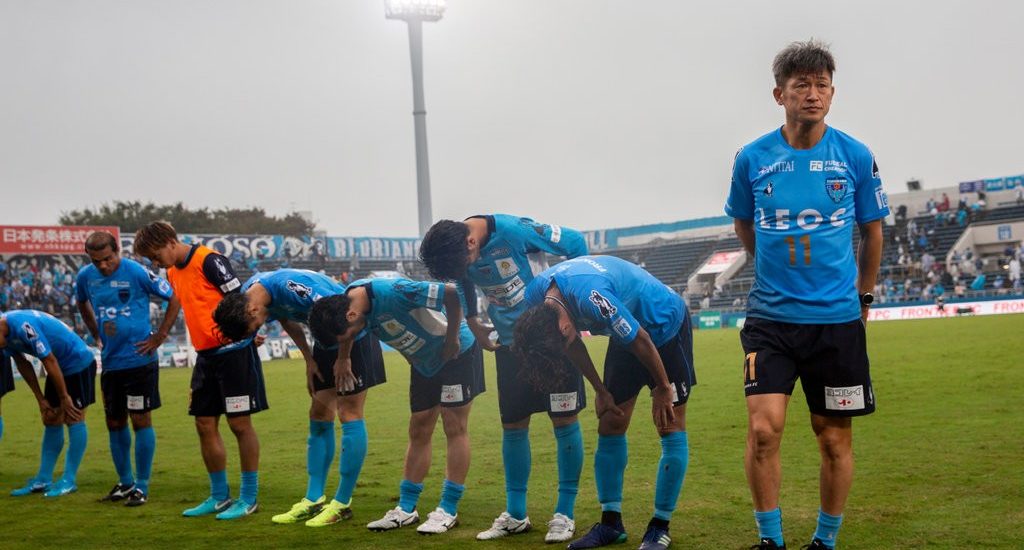- January 6, 2019
- Posted by: worldsoccerinstitute.com
- Category: Business plans

YOKOHAMA, Japan — A typhoon approached. Rain arrived by kickoff. Everyone in the sparse crowd seemed to be wearing a poncho or holding an umbrella.
There was little reason to attend a middling second-division match here on the last day of September, but Junichi Onishi, 61, had an assignment. He has covered soccer for three decades for Sports Nippon, Japan’s oldest sports newspaper. And he was on watch.
“In case Kazu plays,” Onishi said.
He was referring to Kazuyoshi Miura, the pioneering and flamboyant Japanese forward who is still going at age 51. Last year, Miura became what was believed to be the oldest professional player to score a goal, pouncing on a rebound at 50 years 14 days and launching into a samba strut known as the Kazu Dance.
Of course, these things can never be said with complete certainty. Even Miura is quick to offer a caveat. “I’m sure there is someone in fourth or fifth league in Brazil who scored at 54,” he said.
His hair has gone gray and his playing time is scant, his dancing scarce. As September ended, Miura had made only eight appearances in Yokohama F.C.’s first 35 matches in the J2 League, all off the bench, and none since late July. And there has not been a single goal to leave him shaking his hips as if at Carnival.
“When you are 51 years old, you lose power; fitness is very complicated,” said Edson Tavares, Yokohama’s Brazilian manager. “I have to be honest with him. When it’s possible, I use him.”
He is up at 5 in the morning for breakfast, prepared by a personal nutritionist. If his iron levels are low, he finds a restaurant and eats liver. After training, he dips his legs in an ice bath and drinks what some say is a large amount of orange juice. Only it is not orange juice; it is special carbonated water from Italy.
Into his 30s, according to the Japanese sports magazine Number, Miura could eat an entire cake by himself. Now it’s all high protein and low fat, steak fillets and salad with olive oil for dressing. A sports website called Spollup reported that he checks his weight and body fat four or five times a day.
“Japan needs to grow little steps to be high professional,” Tavares said. “Kazu gives a good example, pushing people, motivating the players.”
His face still appears on billboards, and his No. 11 can be found on everything from replica jerseys to cellphone covers. He is widely viewed as gracious, unpretentious, dutiful with fans to shake hands and sign autographs, even if his availability to the news media can be as elusive as his playing time.


He is considered by many Japan’s first soccer superstar. He played in Brazil for Santos, Pelé’s old club, and for Genoa in Italy and Dynamo Zagreb in Croatia. When the J League began play in 1993, Miura brought flair with the way he played and spoke his mind. He was honored as the league’s first most valuable player, and accepted the award in a red suit.
“Without Kazu, the league would never have been as successful as it is,” said Kenji Hattori, the general manager of Yokohama F.C.
Beyond soccer, Miura represents the possibilities of aging productively in a country that, according to the World Economic Forum, is second only to Hong Kong with an average life expectancy of 83.8 years.
“We cannot just sit and draw a line at a certain age,” said Nobuko Kamiya, 68, a retired teacher who follows Yokohama F.C. at home and on the road. “Kazu gave me the inspiration to keep on going; something may come to you.”
Why does he keep playing at 51? Because he loves soccer and has avoided serious injury, Miura told The Japan Times last year. Some fans and reporters believe he is still spurred, two decades later, by the slight of being omitted from Japan’s team for its inaugural appearance in the World Cup, in 1998.

Such players appear to be on an unending search of what the Japanese call “youshikibi,” the beauty of form, Ishijima said. “It’s like Chuck Yeager chasing demons beyond the sound barrier,” she said, referring to the famed American test pilot.
Over the summer, Miura traveled with a friend, the photographer Goya Nagawa, to see Japan play in the World Cup in Russia. He exchanged emails with players on the national team, Nagawa said, and joked that they should tell Japan’s coach, Akira Nishino, “I’m available if he needs me; I can play 15 minutes.”
He is always available. On Sept. 30, as Yokohama F.C. fell behind Renofa Yamaguchi F.C. in the first minute and scrambled futilely to catch up, Miura retreated to a sheltered area behind the bench. He placed a mat on the concrete and did planks and situps. He stayed ready but was not called on in a 3-2 defeat.

Afterward, Miura stood with his teammates, bowed to the crowd, waved and then disappeared beneath the stands. It was midafternoon. Typhoon Trami churned toward Japan. A fierce wind was on the way. Some trains would soon stop operating.
“Please go home early,” the public address announcer said.
A while later, Miura left the stadium in a cap and sunglasses, without saying a word. Onishi, the sportswriter, would have to wait at least another week to get his story.

